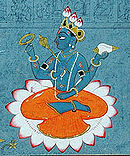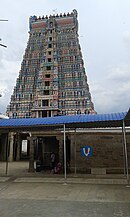Andal (Tamil: ஆண்டாள், Äṇɖāḷ ) or Godadevi is the only female Alvar among the 12 Alvar saints of South India. The Alvar saints are known for their affiliation to the Srivaishnava tradition of Hinduism. Active in the 8th-century,[2][4] with some suggesting 7th-century,[3][note 1] Andal is credited with the great Tamil works, Thiruppavai and Nachiar Tirumozhi, which are still recited by devotees during the winter festival season of Margazhi. Andal is an important female figure for women in South India and has inspired women's groups such as Goda Mandal.
Andal
Godadevi | |||||||||||||||||||||||||||||||||||||||||||||||||||||||||||||||||||||||||||||||||||||||||||||||||||||||||||
|---|---|---|---|---|---|---|---|---|---|---|---|---|---|---|---|---|---|---|---|---|---|---|---|---|---|---|---|---|---|---|---|---|---|---|---|---|---|---|---|---|---|---|---|---|---|---|---|---|---|---|---|---|---|---|---|---|---|---|---|---|---|---|---|---|---|---|---|---|---|---|---|---|---|---|---|---|---|---|---|---|---|---|---|---|---|---|---|---|---|---|---|---|---|---|---|---|---|---|---|---|---|---|---|---|---|---|---|

Devi Andal or Godadevi idol
| |||||||||||||||||||||||||||||||||||||||||||||||||||||||||||||||||||||||||||||||||||||||||||||||||||||||||||
| Personal | |||||||||||||||||||||||||||||||||||||||||||||||||||||||||||||||||||||||||||||||||||||||||||||||||||||||||||
| Born |
Kodhai
7th or 8th century CE[1][2][3] | ||||||||||||||||||||||||||||||||||||||||||||||||||||||||||||||||||||||||||||||||||||||||||||||||||||||||||
| Religion | Hinduism | ||||||||||||||||||||||||||||||||||||||||||||||||||||||||||||||||||||||||||||||||||||||||||||||||||||||||||
| Philosophy | Vaishnavism Bhakti | ||||||||||||||||||||||||||||||||||||||||||||||||||||||||||||||||||||||||||||||||||||||||||||||||||||||||||
| Religious career | |||||||||||||||||||||||||||||||||||||||||||||||||||||||||||||||||||||||||||||||||||||||||||||||||||||||||||
| Literary works | Thiruppavai, Nachiar Tirumozhi | ||||||||||||||||||||||||||||||||||||||||||||||||||||||||||||||||||||||||||||||||||||||||||||||||||||||||||
HonorsLegend of AndalPeriazhwar (originally called Vishnuchittar) was an ardent devotee of Perumal and he used to string garland to Perumal every day. He was childless and he prayed to Perumal to save him from the longing. One day, he found a girl child under a Tulasi plant in a garden inside the temple. The child was goddess Sri Mahalakshmi herself incarnated to test the devotion of alvars. He and his wife named the child as Kothai, who grew up as a devotee of Kannan, an avatar of Perumal. She is believed to have worn the garland before dedicating it to the presiding deity of the temple. Periazhwar, who later found it, was highly upset and remonstrated her. Sri Vishnudeva appeared in his dream and asked him to dedicate only the garland worn by Andal to him. The girl Kothai was thus named Andal and was referred as சூடிகொடுத்த சுடர்க்கொடி,or Chudikodutha Sudarkodi (lady who wore and gave her garland) to Lord Vishnu. The practise is followed during modern times when the garland of Andal from Srivilliputhur Andal Temple is sent to Tirumala Venkateswara Temple on Garudotsavam during the Tamil month of Purattaasi (September – October) and Azhagar Koyil during Chitra Pournami.[7]Dedication to PerumalKodhai was brought up by Vishnuchitta (Periyalvar) in an atmosphere of love and devotion. As Kodhai grew into a beautiful maiden, her fervor for the Lord Perumal grew to the extent that she decided to marry only the Lord himself. As time passed, her resolve strengthened and she thought constantly about marrying Ranganathar of Thiruvarangam (the reclining form of Perumal).[8][9]Andal's BhaktiIn North India, Radha Rani is celebrated as the "Queen of Bhakti (devotion)." Among the female devotees, Mirabai's name is also taken as an example of complete devotion or Bhakti to Lord Krishna. Similarly, in Tamil Nadu Andal is remembered for her pure love and devotion. In the Thiruppavai, Andal, as a Gopi in Ayarpadi (Brindavan),[10] emphasizes that the ultimate goal of life is to seek surrender and refuge at the Lord's feet.Andal's GarlandsIt is also believed that Ranganatha of Ranganathaswamy temple married Andal, who later merged with the idol. Since Andal married Ranganatha, who came as king Raja Sriman Andhra Vishnu, the presiding deity is called Rangamannar.[11]Andal garland and Tirupati VenkateswaraFor Tirupati Brahmotsavam, garlands worn to Andal in Srivilliputhur temple are sent to Venkateswara Temple at Tirupati in Andhra Pradesh. These traditional garlands are made of tulasi, sevanthi and sampangi flowers. These garlands are worn by Lord Venkateswara during the Garuda seva procession.[12]Every year Tirupati Venkateswara's garland is sent to Srivilliputtur Andal for marriage festival of Andal.[13] KallazhagarAndal garland is also sent to Madurai Kallazhagar temple for the Chithirai Festival.[13]Andal's HairstyleAndal's hairstyle and ornamentation are unique to Kerala. The tuft of hair is worn in front of the head similar to the Nambudiri priests of Kerala[14]Andal's ParrotSrivilliputhur Andal's hand-crafted parrot is made with fresh green leaves each and every day. This parrot is kept in the left hand of Andal.[15] It takes approximately four and half hours to make this parrot. A pomegranate flower for beak and mouth, Bamboo sticks for legs, banana plant, petals of pink oleander and nandiyavattai are used to prepare this parrot.[16]Literary worksAndal composed two literary works, both of which are in Tamil verse form and express literary, philosophical, religious, and aesthetic content.ThiruppavaiHer first work is the Thiruppavai, a collection of 30 verses in which Andal imagines herself to be a Gopi, one of the cowherd girls known for their unconditional devotion to Lord Krishna. In these verses, she describes her yearning to serve Lord Vishnu and achieve happiness not just in this lifetime, but for all eternity. She also describes the religious vows (pavai) that she and her fellow cowherd girls will observe for this purpose. It is said that Thiruppavai is the nectar of Vedas and teaches philosophical values, moral values, ethical values, pure love, devotion, dedication, single-minded aim, virtues, and the ultimate goal of life.[17][18]Nachiar TirumozhiThe second work by Andal is the Nachiar Tirumozhi, a poem of 143 verses. "Thirumozhi" literally means "Sacred Sayings" in a Tamil poetic style and "Nachiar" means Goddess. Therefore, the title means "Sacred Sayings of the Goddess." This poem fully reveals Andal's intense longing for Vishnu, the Divine Beloved. Utilizing classical Tamil poetic conventions and interspersing stories from the Vedas and Puranas, Andal creates imagery that is possibly unparalleled in the whole gamut of Indian religious literature. However, conservative vainava institutions do not encourage the propagation of Nachiar Tirumozhi as much as they encourage Thiruppavai because Nachiar Tirumozhi belongs to an erotic genre of spirituality that is similar to Jayadeva's Gita Govinda.[19][20][21][22][23]Importance in southern part of India
Andal Temple of the Hoysala period, Chennakeshava Temple, Belur
FestivalsThousands of people from the state Tamil Nadu participate in the "Aadi Pooram" festival celebrated in the Andal Temple. After early morning special pujaas, the presiding deities, Shri Rengamannar and Goddess Andal are taken in decorated palanquins to the car. The festival marks the adoption of presiding deity, Andal, by Periyazhwar after he found her near a Tulsi plant in the garden of Vatapatrasayi Temple at Srivilliputhur on the eighth day of the Tamil month of Aadi.[27][28]Women groups inspired by AndalIn poetry, 9th-century Andal became a well known Bhakti movement poetess, states Pintchman, and historical records suggest that by 12th-century she was a major inspiration to Hindu women in south India and elsewhere.[6] Andal continues to inspire hundreds of classical dancers in modern times choreographing and dancing Andal's songs.[29] Andal is also called Goda, and her contributions to the arts have created Goda Mandali (circle of Andal) in the Vaishnava tradition.[29]Through poetry of saints (such as Andal) women are thought to be able to connect with the Lord directly and those words are thought to encapsulate their personal emotions.[6] Goda MandaliGoda Mandali (circle) which was named after Andal was formed in 1970 and reorganized in 1982 spreads Andal songs widely through TV and radio programs.[30][31] The group would gather weekly to learn songs and would sing at events such as festivals where they would raise money for shrines.[31]Contemporary commentaries and inspired poemsBhakti PoetryIn contemporary commentaries on Tamil bhakti poetry, A.K. Ramanujan's work remarks on how many other religious traditions would keep and treat passionate love and devotion to God as separate, while in the bhakti tradition, they can be in resonance with one another:"All devotional poetry plays on the tension between saguna and nirguna, the lord as person and the lord as principle. If he were entirely a person, he would not be divine, and if he were entirely a principle, a godhead, one could not make poems about him. The Vaishnavas, too, say that the lord is characterized by both 'paratva, 'otherness' and soulabhaya, 'ease of access'; he is both here and beyond, both tangible as a person and intangible as a principle-such is the nature of the ground of all being. It is not either/or, but both and; myth, bhakti and poetry would be impossible without the presence of both attitudes". Prentiss, Karen Pechilis (1999). The Embodiment of Bhakti. OUP. p. 25. ISBN 9780195128130. Feminist InterpretationsAndal's PoetryIt is thought that women used poetry as a tool in Hindu society as a way to claim a form of agency.[32]Feminist interpretations look at some of Andal's verses as her open acknowledgement of her love for Lord Vishnu, written with bold sensuality and startlingly savage longing, hunger and inquiry as widely found in Tamil Sangam literature that express women's longings and their separation from their men; even today, her most erotic poems are rarely rendered publicly.[33] In one such verse Andal dispenses with metaphor and imagines herself lying in the arms of Krishna, making love to him:[34]
My life will be spared
William Dalrymple- In search of Tamil Nadu's poet-preachers[35][36]
Only if he will come To stay for me for one night If he will enter me, So as to leave the imprint of his saffron paste upon my breasts Mixing, churning, maddening me inside, Gathering my swollen ripeness Spilling nectar, As my body and blood Bursts into flower.
tell him I will survive
Vidya – The Body Adorned: Sacred and Profane in Indian Art(p. 140)[37]
only if he will stay with me for one day – enter me so as to wipe away the saffron paste adorning my breasts Andal admiring herself whilst wearing the garland that was meant for the deity:
the guilt glazed love lay on Andal's breasts.
- Meena Kandasamy, Ms Militancy[38][39][40]
thick and heavy as him. frightened with force and locked away, she conjured him every night, her empurumaan, her emperor-man. In one of her poems, Andal says that her voluptuous breasts will swell for the Lord alone, and scorns the idea of making love to mortal beings, comparing that with the sacrificial offering made by Brahmins being violated by jackals in the forest,[41] and in another verse she dedicates her swelling breasts to the Lord who carries a conch.[36]
My surging breasts long to leap to the touch of his hand which holds aloft the flaming discus and the conch.
Coax the world-measurer to caress my waist, to encircle the twin globes of my breasts
[42][43]
Marriage to VishnuContemporary interpretations view her act of marrying Vishnu as feminist.[44] Divine marriages and virginity allowed women's subjectivity, as she is able to choose her husband, and given an "aristocratic freedom".[45] It is said that by devoting herself to God and rejecting marrying a human, she avoided the regular duties involved with being a wife that would inhibit her freedom.[44] Feminist interpretations see Andal's pursuit of marrying Vishnu as rejecting the patriarchal institution of marriage.[44] Virgins with divine marriages were often able to practice educational freedom through reading and/or writing[45] such as Andal did.Quoted from Feminism and world religions by Arvind Sharma, Katherine K. Young: "What Andal and other women poets did by living the way they did was to negotiate a space within a marriage-dominated society and made at least some sections of society make room for them".[44] Andal fulfilled the expectation of becoming a wife by marrying God, but since her husband was divine, she gained her autonomy.[44] This act is referred to as virginal feminism by numerous scholars in patristic theology.[46] Virginity is viewed as giving women the option to avoid childbearing, "male domination" and live a new life of devotion to God.[46] Krishnadevaraya's AmuktamalyadaKrishnadevaraya of the Vijayanagar Dynasty composed the epic poem Amuktamalyada in Telugu, which is considered as a masterpiece. Amuktamalyada translates to one who wears and gives away garlands, and describes the story of Andal or Goda Devi, the daughter of Periyalvar.[47]Amuktamalyada describes pain of separation (viraha) experienced by Andal, who is described as the incarnate of Lakshmi the consort of Vishnu. Further the poem describes Andal's beauty in 30 verses written in the keśādi-pādam style, starting from her hair, going down her body till her feet.[48][49] MangalasasanamAndal has sung in praise of eleven holy sites:[50]
| Alvars |
| |||||||||||||||||||||||||||||||||||||||||||||||||||||||||||||||||||||||||||||||||||||||||||||||||||||||||













No comments:
Post a Comment